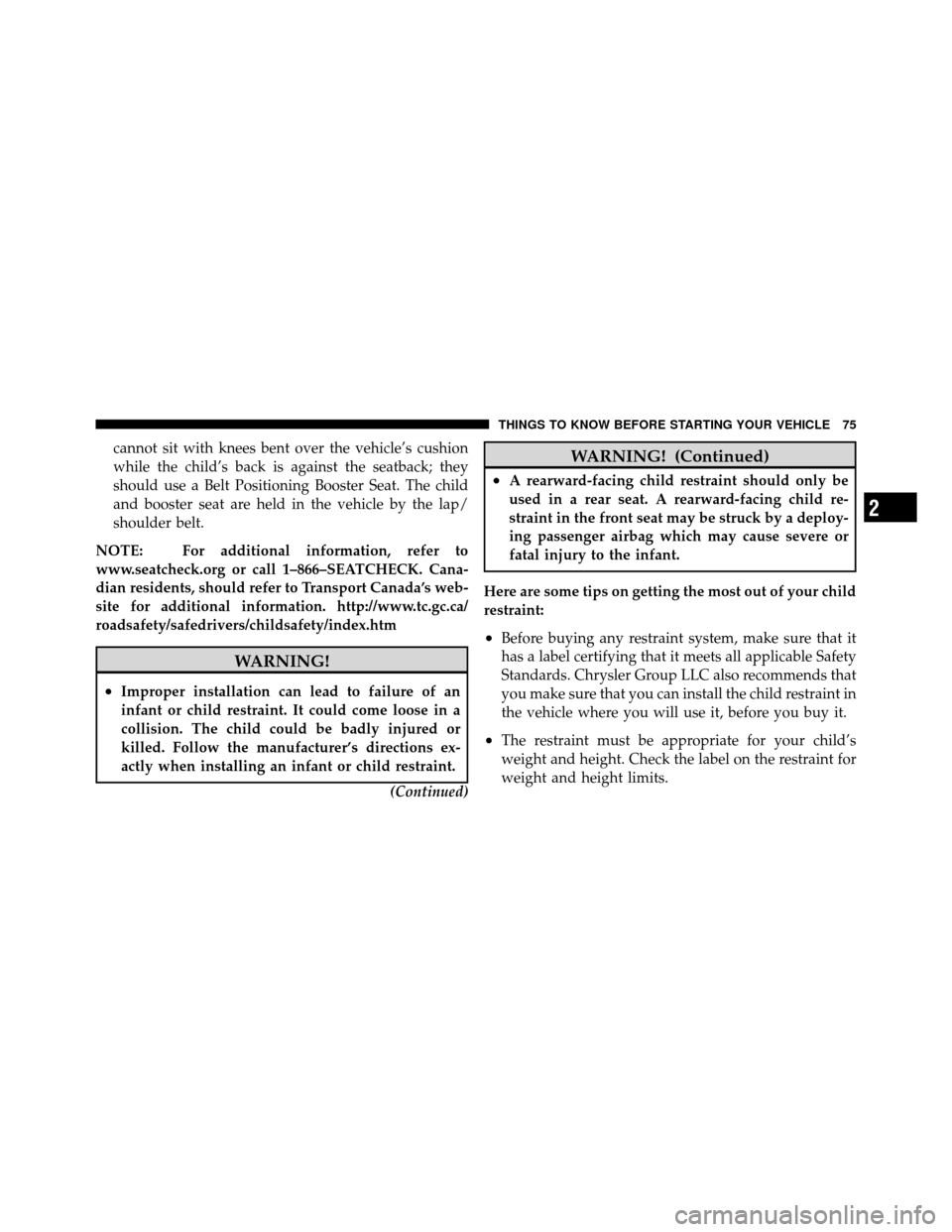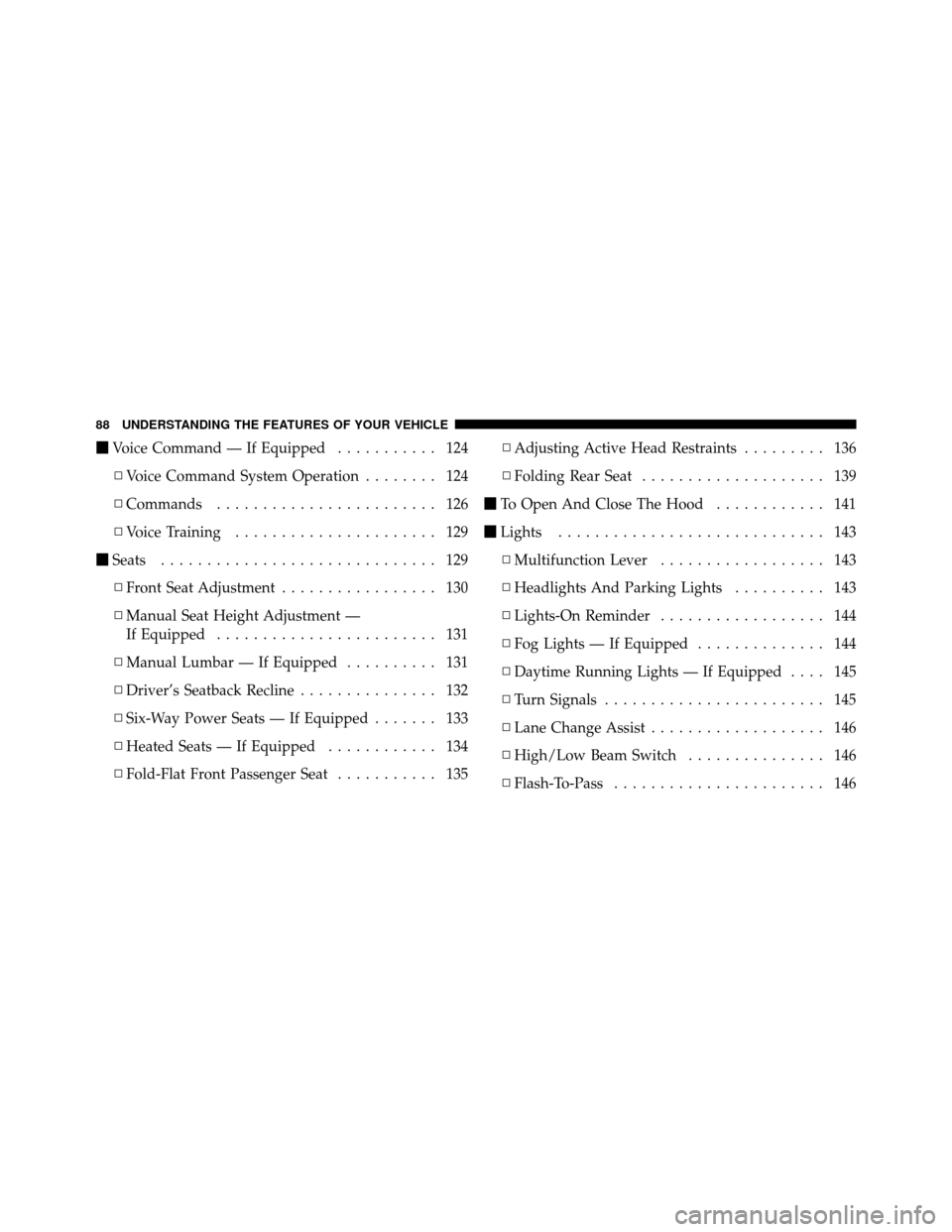Page 76 of 496

cannot sit with knees bent over the vehicle’s cushion
while the child’s back is against the seatback; they
should use a Belt Positioning Booster Seat. The child
and booster seat are held in the vehicle by the lap/
shoulder belt.
NOTE: For additional information, refer to
www.seatcheck.org or call 1–866–SEATCHECK. Cana-
dian residents, should refer to Transport Canada’s web-
site for additional information. http://www.tc.gc.ca/
roadsafety/safedrivers/childsafety/index.htm
WARNING!
•Improper installation can lead to failure of an
infant or child restraint. It could come loose in a
collision. The child could be badly injured or
killed. Follow the manufacturer’s directions ex-
actly when installing an infant or child restraint. (Continued)
WARNING! (Continued)
•A rearward-facing child restraint should only be
used in a rear seat. A rearward-facing child re-
straint in the front seat may be struck by a deploy-
ing passenger airbag which may cause severe or
fatal injury to the infant.
Here are some tips on getting the most out of your child
restraint:
•Before buying any restraint system, make sure that it
has a label certifying that it meets all applicable Safety
Standards. Chrysler Group LLC also recommends that
you make sure that you can install the child restraint in
the vehicle where you will use it, before you buy it.
•The restraint must be appropriate for your child’s
weight and height. Check the label on the restraint for
weight and height limits.
2
THINGS TO KNOW BEFORE STARTING YOUR VEHICLE 75
Page 89 of 496

�Voice Command — If Equipped ........... 124
▫ Voice Command System Operation ........ 124
▫ Commands ........................ 126
▫ Voice Training ...................... 129
� Seats .............................. 129
▫ Front Seat Adjustment ................. 130
▫ Manual Seat Height Adjustment —
If Equipped ........................ 131
▫ Manual Lumbar — If Equipped .......... 131
▫ Driver’s Seatback Recline ............... 132
▫ Six-Way Power Seats — If Equipped ....... 133
▫ Heated Seats — If Equipped ............ 134
▫ Fold-Flat Front Passenger Seat ........... 135▫
Adjusting Active Head Restraints ......... 136
▫ Folding Rear Seat .................... 139
� To Open And Close The Hood ............ 141
� Lights ............................. 143
▫ Multifunction Lever .................. 143
▫ Headlights And Parking Lights .......... 143
▫ Lights-On Reminder .................. 144
▫ Fog Lights — If Equipped .............. 144
▫ Daytime Running Lights — If Equipped .... 145
▫ Turn Signals ........................ 145
▫ Lane Change Assist ................... 146
▫ High/Low Beam Switch ............... 146
▫ Flash-To-Pass ....................... 146
88 UNDERSTANDING THE FEATURES OF YOUR VEHICLE
Page 132 of 496
Manual Seat Height Adjustment — If Equipped
The driver’s seat height can be raised or lowered by using
the handle on the outboard side of the seat to adjust the
driving position.
Manual Lumbar — If Equipped
The lumbar adjustment handle is located on the outboard
side of the driver’s seat. To increase or decrease support,
rotate the handle up or down.
Seat Height AdjustmentLumbar Adjustment
3
UNDERSTANDING THE FEATURES OF YOUR VEHICLE 131
Page 335 of 496
Tire Sizing Chart
EXAMPLE:
Size Designation:
P= Passenger car tire size based on U.S. design standards
�....blank....� = Passenger car tire based on European design standards
LT = Light truck tire based on U.S. design standards
T = Temporary spare tire
31 = Overall diameter in inches (in)
215 = Section width in millimeters (mm)
65 = Aspect ratio in percent (%)
— Ratio of section height to section width of tire
10.5 = Section width in inches (in)
R = Construction code
—�R� means radial construction
—�D� means diagonal or bias construction
15 = Rim diameter in inches (in)
334 STARTING AND OPERATING
Page 372 of 496

Frontal Area
The frontal area is the maximum height multiplied by the
maximum width of the front of a trailer.
Trailer Sway Control
The trailer sway control is a telescoping link that can be
installed between the hitch receiver and the trailer tongue
that typically provides adjustable friction associated with
the telescoping motion to dampen any unwanted trailer
swaying motions while traveling.
Weight-Carrying Hitch
A weight-carrying hitch supports the trailer tongue
weight, just as if it were luggage located at a hitch ball or
some other connecting point of the vehicle. These kind of
hitches are the most popular on the market today and
they are commonly used to tow small- and medium-
sized trailers.
Weight-Distributing Hitch
A weight-distributing system works by applying lever-
age through spring (load) bars. They are typically used
for heavier loads, to distribute trailer tongue weight to
the tow vehicle’s front axle and the trailer axle(s). When
used in accordance with the manufacturers’ directions, it
provides for a more level ride, offering more consistent
steering and brake control, thereby enhancing towing
safety. The addition of a friction/hydraulic sway control
also dampens sway caused by traffic and crosswinds and
contributes positively to tow vehicle and trailer stability.
Trailer sway control and a weight distributing (load
equalizing) hitch are recommended for heavier Tongue
Weights (TW) and may be required depending on Vehicle
and Trailer configuration/loading to comply with Gross
Axle Weight Rating (GAWR) requirements.
5
STARTING AND OPERATING 371